Introduction
In the heart of India’s cultural heritage lies a profound tapestry of temples, each telling a story of spiritual devotion, artistic brilliance, and historical legacy. The significance of temples in India transcends mere architectural marvels; they serve as sanctuaries of faith, repositories of cultural identity, and living embodiments of centuries-old traditions.
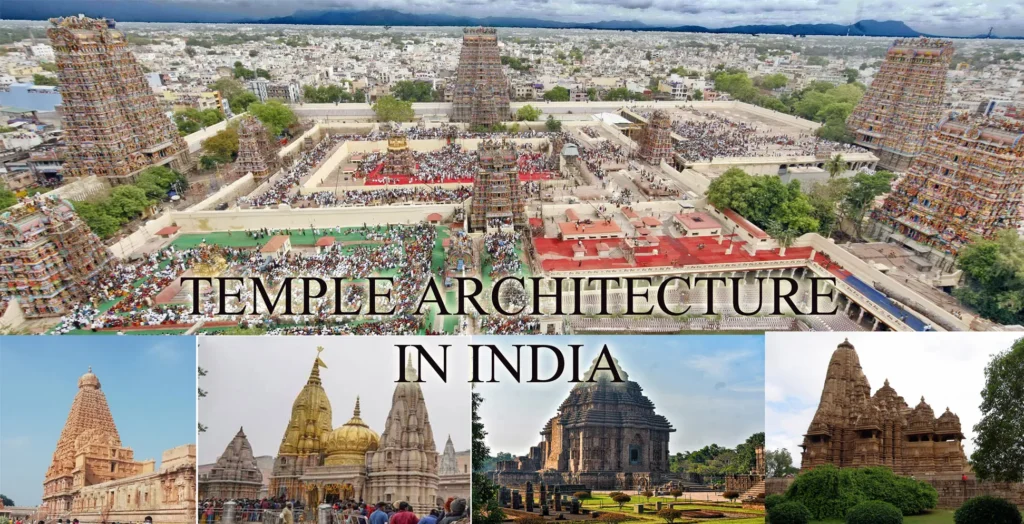
Rich Cultural and Historical Significance
Temples in India stand as timeless witnesses to the evolution of society, religion, and art. From the ancient temples carved into rock formations to towering structures adorned with intricate sculptures, each edifice encapsulates the spiritual essence of the region it resides in. These sacred spaces have been the cradle of cultural practices, hosting rituals, festivals, and ceremonies that bind communities together.
The historical importance of temples is deeply interwoven with India’s tapestry, reflecting the patronage of different rulers and dynasties. They are not just places of worship but also repositories of historical events, showcasing the ebb and flow of various civilizations that have left their indelible mark on the subcontinent.
Diversity of Architectural Styles
One of the remarkable aspects of Indian temple architecture is its astonishing diversity. The country boasts several distinct architectural styles, each flourishing in different regions and periods. The Nagara style, prevalent in North India, is characterized by its lofty towers and intricate carvings. In contrast, the Dravida style, found predominantly in the South, showcases pyramid-shaped towers and intricately carved pillars.
The Vesara style, a harmonious blend of Nagara and Dravida influences, further enriches the architectural mosaic. These styles are not static but have evolved over centuries, adapting to regional preferences, climatic conditions, and the aesthetics of the ruling dynasties.
Influence of Different Dynasties
Indian temple architecture is a testament to the patronage extended by various dynasties that ruled the subcontinent. The Cholas, Pallavas, and Chalukyas, among others, have left an indelible mark on temple design, shaping the landscape of the regions they governed. The grandeur of Khajuraho Temples, the structural magnificence of Ellora Caves, and the timeless beauty of the Sun Temple at Konark are all reflective of the diverse influences of these dynasties.
As we embark on a journey through the architectural marvels of India’s temples, we unravel not just the stones and sculptures but the very soul of a nation deeply rooted in its spiritual and historical legacy.
If you want to know about the Types of slabs or Permeable concrete or Islamic architecture, please click the link.
1) Evolution of Temple Architecture in India
The evolution of temple architecture in India is a captivating journey through time, marked by the confluence of artistic brilliance, religious fervor, and dynastic patronage. From humble beginnings to soaring heights, each era has contributed to the rich tapestry of India’s sacred structures.
i) Early Temples (B.C.E – 200 C.E):
Mauryan and Sunga Periods: The roots of Indian temple architecture can be traced back to the Mauryan and Sunga periods. During this time, simple rock-cut caves and small shrines laid the groundwork for more elaborate structures.
ii) Gupta Empire (320–550 C.E):
Golden Age of Temple Building: The Gupta Empire witnessed a surge in temple construction. Influenced by Hindu and Buddhist philosophies, temples like the Dashavatara Temple in Deogarh showcased early attempts at structural design.
iii) Chalukya and Pallava Dynasties (550–750 C.E):
Early Dravida Style: The Chalukyas and Pallavas in South India played a pivotal role in shaping the Dravida style. Mamallapuram’s Shore Temple and Badami Cave Temples are notable examples, featuring distinctive pyramid-shaped towers and intricately carved pillars.
iv) Rashtrakuta and Chola Dynasties (750–1150 C.E):
Culmination of Dravida Style: The Rashtrakutas and Cholas further refined the Dravida style. The Brihadeeswarar Temple in Thanjavur, commissioned by Rajaraja Chola, stands as a colossal testament to their architectural prowess.
v) Hoysala Empire (1040–1346 C.E):
Intricate Sculptural Details: The Hoysalas introduced a unique style characterized by intricate sculptural details. Temples like the Chennakesava Temple in Belur and the Hoysaleswara Temple in Halebidu showcase unprecedented craftsmanship.
vi) Vijayanagara Empire (1336–1646 C.E):
Fusion of Architectural Styles: The Vijayanagara Empire witnessed a fusion of various styles, resulting in monumental structures like the Virupaksha Temple in Hampi. The empire’s patronage led to the creation of grandiose complexes with ornate carvings.
vii) Mughal and Maratha Periods (1526–1818 C.E):
Syncretic Architectural Expressions: The Mughal influence, seen in structures like the Kailasa Temple in Ellora, brought about a syncretic blend of architectural elements. The Marathas continued this trend, contributing to the synthesis of diverse styles.
viii) British Colonial Period to Present Day (1818 C.E – Present):
Impact of Colonial Rule: The British colonial period saw neglect and destruction of some temples. However, post-independence, efforts have been made to preserve and restore these cultural treasures. Modern architects continue to draw inspiration from traditional styles while incorporating contemporary elements.
The evolution of temple architecture in India is a testament to the nation’s resilience, adaptability, and unwavering commitment to preserving its cultural heritage. As we explore these architectural marvels, we unravel the threads that connect the past with the present, creating a narrative that echoes through the corridors of time.
2) Major Architectural Styles of Indian Temples
Indian temple architecture is a kaleidoscope of styles, each reflecting the unique cultural and regional nuances of the subcontinent. Among the myriad architectural expressions, three major styles stand out prominently: Nagara, Dravida, and Vesara.
i) Nagara Style:
Regional Prevalence: Predominantly found in Northern India.
Distinctive Features:
- Shikhara (Tower): Nagara temples are characterized by a curvilinear tower or shikhara, often tall and elaborately decorated.
- Mandapa and Garbhagriha: Temples typically consist of a pillared hall (mandapa) leading to the sanctum sanctorum (garbhagriha).
- Amalaka and Kalasha: Crowning the shikhara, the amalaka (disk-like motif) and kalasha (pot-like finial) are prominent features.
Notable Examples: Kandariya Mahadeva Temple in Khajuraho, Kashi Vishwanath Temple in Varanasi.

ii) Dravida Style:
Regional Prevalence: Primarily found in Southern India.
Distinctive Features:
- Vimana (Tower): Dravida temples feature a pyramidal tower or vimana, with horizontal levels known as talas.
- Shrines and Enclosed Prakara: Temples often have multiple shrines within an enclosed prakara (wall), creating a complex layout.
- Raya Gopuram: Grand entrance towers, known as raya gopurams, are common in large Dravida temples.
Notable Examples: Brihadeeswarar Temple in Thanjavur, Meenakshi Amman Temple in Madurai.
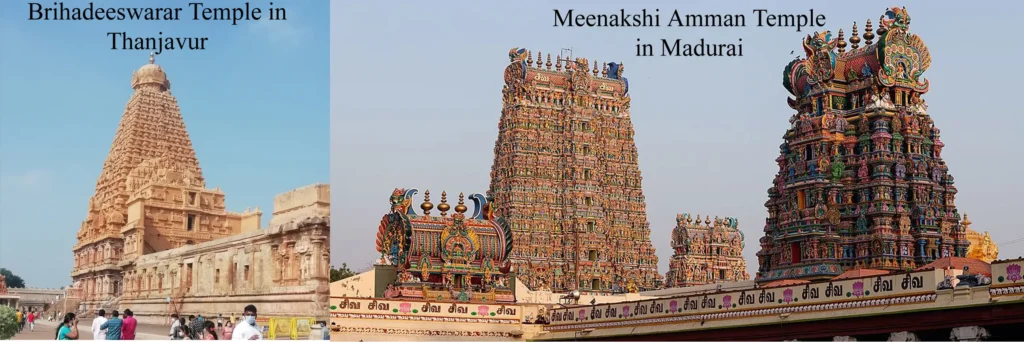
iii) Vesara Style:
Regional Prevalence: A harmonious blend found in Central and Western India.
Distinctive Features:
- Combination of Nagara and Dravida Elements: Vesara style combines elements of both Nagara and Dravida, showcasing a fusion of architectural traits.
- Diversity in Pillars and Sculptures: Pillars may exhibit intricate carvings, and sculptures could represent a mix of deities and mythological narratives.
Notable Examples: Hoysaleswara Temple in Halebidu, Mallikarjuna Temple in Basaralu.
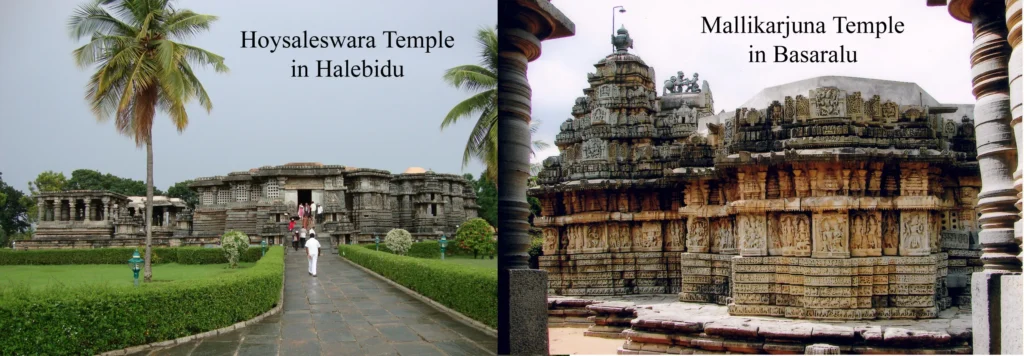
Regional Variations
- Nagara in North India: The Nagara style in the north exhibits variations such as the Bhumija and Phamsana sub-styles, each with unique tower designs and ornamentation.
- Dravida in South India: Dravida style showcases regional variations, with the Tamil, Vijayanagara, and Chola sub-styles, each influencing the layout and embellishments of temples differently.
- Vesara in Central and Western India: The Vesara style may vary in prominence of Nagara or Dravida elements, resulting in diverse expressions based on regional preferences.
These architectural styles, like threads in a grand tapestry, weave together the cultural, religious, and historical narratives of India. Each style, with its distinct features and regional variations, contributes to the rich and vibrant mosaic that defines the architectural landscape of Indian temples.
3) Symbolic Elements and Iconography in Indian Temple Architecture
Indian temple architecture serves as a canvas for intricate symbolism and profound iconography, where every sculpted detail, carving, and artistic element conveys a deeper religious and cultural narrative. From the grand entrance to the inner sanctum, each facet tells a story that transcends time and space.
i) Entrance and Gopurams:
- Symbolism: Gopurams, or entrance towers, often depict celestial beings, deities, and mythological scenes. They symbolize the transition from the mundane to the sacred, inviting devotees into the divine realm.
- Iconography: Intricate carvings on gopurams narrate episodes from religious texts, showcasing the temple’s allegiance to a particular deity or sect.
ii) Pillars and Mandapas:
- Symbolism: Pillars, often adorned with ornate carvings, represent the cosmic axis connecting the earth to the divine realms. Mandapas (halls) symbolize the gathering of devotees for rituals and ceremonies.
- Iconography: Carvings on pillars depict gods, goddesses, celestial beings, and mythological stories. The placement of pillars is carefully orchestrated to create a sacred space for congregational activities.
iii) Sculptures on Temple Walls:
- Symbolism: Sculptures on temple walls convey moral, ethical, and spiritual teachings. They serve as visual metaphors, guiding devotees on the path of righteousness.
- Iconography: Scenes from epics like the Ramayana and Mahabharata, depictions of deities in various forms (avatars), and celestial dancers adorn the walls, illustrating divine narratives.
iv) Garbhagriha (Sanctum Sanctorum):
- Symbolism: The Garbhagriha represents the womb of creation, where the main deity resides. It symbolizes the divine presence and the center of cosmic energy.
- Iconography: The idol or image of the deity within the sanctum is crafted with precision, adhering to specific iconographic guidelines. Mudras (hand gestures) and ornaments convey the deity’s attributes.
v) Temple Towers (Shikhara/Vimana):
- Symbolism: Towers symbolize the ascent from the earthly to the celestial realms. Their shape, size, and ornamentation carry symbolic significance.
- Iconography: Sculptures on the towers depict gods, goddesses, and celestial beings, emphasizing the temple’s dedication to a particular deity or religious tradition.
vi) Kirtimukha and Makara Toranas:
- Symbolism: Kirtimukha, often seen above temple doorways, represents the devouring of time and worldly desires. Makara toranas, or archways adorned with mythical sea creatures (makaras), symbolize protection.
- Iconography: Intricate carvings on these elements may include deities, auspicious symbols, and mythological scenes, infusing protective and auspicious energies.
vii) Yalis and Animal Motifs:
- Symbolism: Yalis, mythical lion-like creatures, symbolize power and protection. Animal motifs represent the interconnection between the natural and divine worlds.
- Iconography: Elaborate carvings of yalis and animals showcase the artisan’s skill and convey symbolic meanings related to cosmic order and divine attributes.
In essence, the symbolic elements and iconography within Indian temple architecture transcend mere aesthetics. They serve as a sacred language, communicating profound spiritual truths and cultural values to generations of worshippers, making each temple a living testament to the rich tapestry of India’s religious and cultural heritage.
4) Iconic Temples Showcasing Architectural Diversity Across Historical Periods
India’s landscape is adorned with iconic temples that stand as testaments to the architectural brilliance and cultural richness of various historical periods. Here are three exemplary temples, each representing a different architectural style and period:
i) Brihadeeswarar Temple, Thanjavur (Dravida Style – 11th Century)

Architectural Style: Dravida
Period: Chola Dynasty (Built in 1010 C.E by Rajaraja Chola I)
Key Features:
- Grand Vimana (Tower): The Brihadeeswarar Temple boasts a towering vimana that rises to a height of 216 feet, showcasing the mastery of Dravida architecture.
- Kumbam (Kalasha): The octagonal shikhara is crowned by a massive kalasha (pot-like finial), symbolizing auspiciousness.
- Nandi Mandapam: The temple complex includes a large Nandi (bull) statue in a separate mandapam, facing the main sanctum.
ii) Khajuraho Temples (Nagara Style – 10th-12th Centuries):

Architectural Style: Nagara
Period: Chandela Dynasty (Constructed between 950 and 1150 C.E)
Key Features:
- Exquisite Sculptures: The temples are renowned for their intricate and sensuous sculptures, depicting various aspects of life, divine beings, and celestial dancers.
- Shikharas: Though smaller in height compared to Dravida style, the temples feature multiple shikharas with ornate carvings.
- Varied Deities: The temples are dedicated to different deities, including Vishnu and Shiva, reflecting the religious tolerance of the Chandela rulers.
iii) Sun Temple, Konark (Kalinga Style – 13th Century):
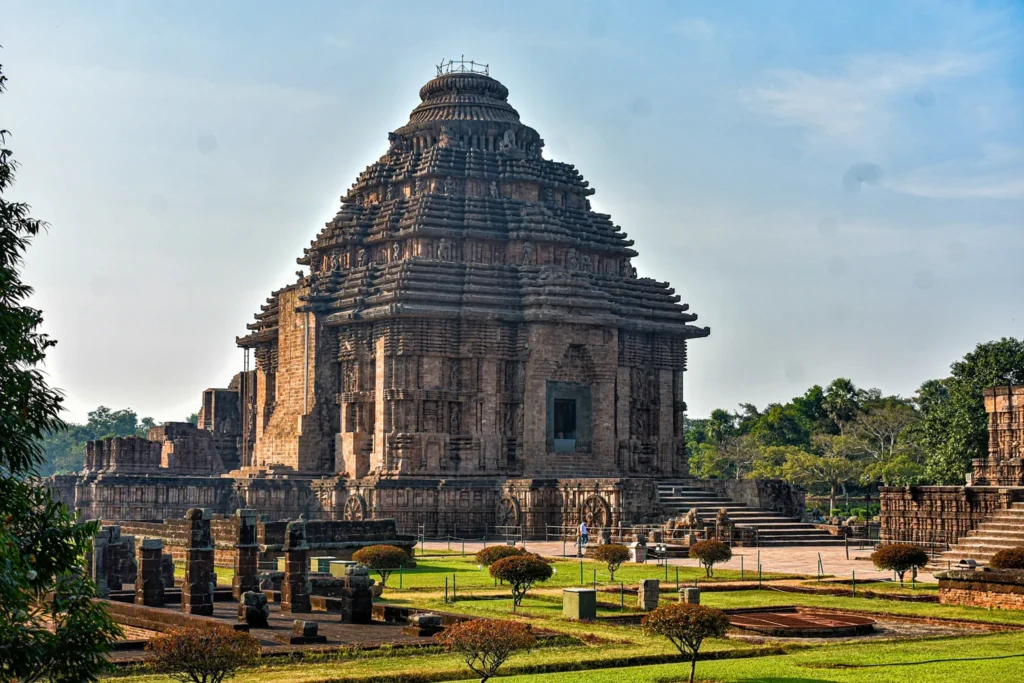
Architectural Style: Kalinga (A subtype of Nagara)
Period: Eastern Ganga Dynasty (Built in 13th century by King Narasimhadeva I)
Key Features:
- Magnificent Chariot: The temple is designed in the shape of a colossal chariot with intricately carved wheels and horses, dedicated to the Sun God, Surya.
- Sculptural Details: Elaborate carvings depict scenes from everyday life, mythological narratives, and celestial beings.
- Innovative Design: The temple is renowned for its unique engineering, with the main temple designed to function as a giant sundial.
These iconic temples showcase the diversity of architectural styles and the evolution of temple construction across different historical periods in India. From the towering vimanas of the Cholas to the sensuous sculptures of the Chandelas and the innovative chariot design of the Konark Sun Temple, each monument stands as a living testament to the artistic and cultural vibrancy of its era.
5) Influence of Hinduism, Buddhism, and Jainism on Indian Temple Design
A Harmony of Faith and Architecture: Indian temple design is deeply rooted in the philosophical and cultural tenets of Hinduism, Buddhism, and Jainism. Each of these religions has contributed distinct elements to the architectural landscape, reflecting their unique beliefs and practices.
Hinduism:
Philosophical Influence: Hindu temple architecture is intricately linked with the principles of Vastu Shastra, an ancient architectural treatise. The temple is considered a microcosm of the universe, with its central sanctum symbolizing the cosmic axis connecting the earthly and divine realms.
Cultural Aspects:
- Deity-Centric Design: Hindu temples are dedicated to specific deities, and the architecture revolves around facilitating the devotee’s connection with the divine. The sanctum, housing the main deity’s idol, is the focal point.
- Mandala and Cosmology: Many Hindu temples adhere to a mandala layout, symbolizing the cosmos. The temple’s architectural elements align with cosmic principles, reflecting Hindu cosmology.
Buddhism:
Philosophical Influence: Buddhist temple design reflects the teachings of Siddhartha Gautama (Buddha). The focus is on creating spaces conducive to meditation and enlightenment.
Cultural Aspects:
- Stupas and Chaityas: Buddhist stupas and chaityas are key architectural elements. Stupas represent the Buddha’s presence, while chaityas serve as prayer halls. Examples include the Great Stupa at Sanchi and the Ajanta Caves.

- Simple and Uncluttered Design: Buddhist temples emphasize simplicity and lack elaborate ornamentation. The emphasis is on creating a serene environment conducive to meditation.
Jainism:
Philosophical Influence: Jain temple architecture is rooted in the principles of non-violence (ahimsa) and asceticism. Jain temples often have elaborate decorations but avoid harming living beings in the process.
Cultural Aspects:
- Dome-Shaped Shikharas: Jain temples typically feature dome-shaped shikharas, symbolizing spiritual ascent. Intricate carvings depict Tirthankaras and Jain cosmology.
- Mandapas and Pillars: Elaborate mandapas and intricately carved pillars are common in Jain temples. The Ranakpur Jain Temple is an excellent example of Jain architectural grandeur.
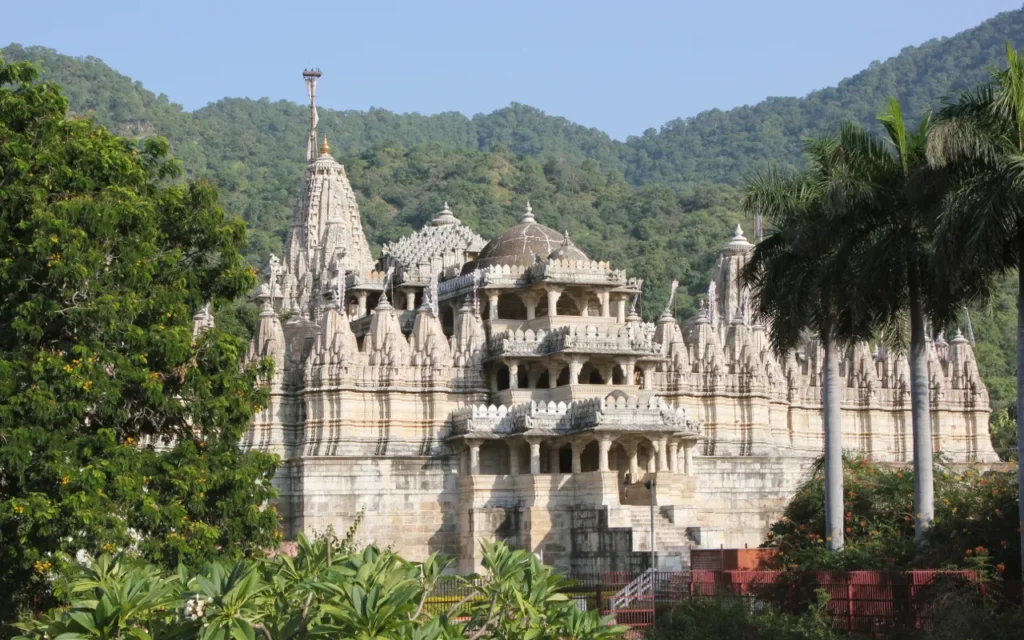
Cultural and Philosophical Commonalities
- Symbiosis of Art and Spirituality: All three religions emphasize the integration of art and spirituality. Temples serve as visual representations of the respective faiths, conveying intricate stories and spiritual teachings through sculpture and architecture.
- Sacred Geometry: Temples often incorporate sacred geometric principles, reflecting the interconnectedness of the physical and metaphysical realms. Mandalas, yantras, and precise alignments contribute to the overall sacred geometry.
Harmony and Diversity: The influence of Hinduism, Buddhism, and Jainism on temple design in India highlights a harmonious coexistence of diverse beliefs. While each religion brings its unique architectural language, the common thread lies in the pursuit of spiritual enlightenment, cultural expression, and the creation of sacred spaces that inspire awe and devotion. The architectural heritage of these religions continues to shape the landscape of India, embodying the rich tapestry of its cultural and philosophical traditions.
6) Challenges Faced by Ancient Temples
Struggles Against Time and Human Impact:
Ancient temples in India, with their intricate architecture and cultural significance, face numerous challenges that threaten their structural integrity and historical value. These challenges stem from both environmental factors and human activities.
Environmental Factors:
- Weathering and Erosion: Exposure to the elements over centuries results in weathering and erosion of temple structures, especially for those made of porous materials like sandstone.
- Climate Extremes: Harsh weather conditions, including intense heat, heavy rains, and humidity, accelerate the degradation of temple exteriors and interiors.
- Natural Disasters: Earthquakes, floods, and other natural disasters pose significant threats to the stability of ancient temples.
Human Activities:
- Pilgrimage-Induced Wear and Tear: High footfall, particularly during religious festivals and pilgrimages, leads to wear and tear of temple flooring, steps, and sculptures.
- Vandalism and Theft: Acts of vandalism, theft of artifacts, and illegal excavation for valuable items contribute to the loss of historical and cultural treasures.
- Modern Constructions: Urbanization and modern development in the vicinity of temples may cause structural damage due to excavation and vibrations from construction activities.
Ongoing Conservation Efforts:
Preserving India’s Temple Heritage: Recognizing the importance of preserving India’s rich temple heritage, various conservation efforts and initiatives have been implemented to address the challenges faced by ancient temples.
Restoration and Conservation Projects:
- Architectural Rehabilitation: Renowned temples like the Konark Sun Temple and Khajuraho Temples have undergone extensive restoration projects to repair damages caused by weathering and natural disasters.
- Structural Stabilization: Conservationists employ advanced engineering techniques to stabilize structures, reinforcing foundations and addressing structural vulnerabilities.
Documentation and Digital Preservation:
- 3D Scanning and Mapping: Modern technologies like 3D scanning and mapping help create detailed digital replicas of temple structures. This aids in documentation and can guide restoration efforts.
- Archival Documentation: Detailed documentation of architectural elements, sculptures, and inscriptions ensures that a comprehensive record exists even if physical structures deteriorate.
Community Involvement and Awareness:
- Community-Led Conservation: Involving local communities in the preservation process fosters a sense of ownership and responsibility.
- Awareness Campaigns: Public awareness campaigns on the cultural and historical significance of temples promote responsible tourism and discourage activities that may harm the heritage sites.
Legal Framework and Regulations:
- Heritage Protection Laws: Implementation and enforcement of heritage protection laws, such as the Ancient Monuments and Archaeological Sites and Remains Act, help safeguard temples from encroachment and unauthorized activities.
- Zoning Regulations: Urban planning regulations and zoning norms around heritage sites aim to control construction activities that could adversely impact ancient temples.
International Collaboration:
- Knowledge Exchange: Collaborations with international organizations and experts facilitate knowledge exchange, bringing global expertise to address conservation challenges.
- Funding Support: International partnerships often provide financial support for large-scale restoration projects.
As India continues to grapple with the dual challenges of environmental degradation and human impact on its ancient temples, the concerted efforts of conservationists, local communities, and authorities are crucial for ensuring that these architectural wonders endure for future generations. The ongoing initiatives underscore the commitment to preserving the cultural and historical treasures that temples represent in the tapestry of India’s heritage.
7) Modern Revival: Blending Tradition with Innovation in Temple Architecture
Contemporary architects are redefining the landscape of temple architecture by seamlessly integrating traditional styles with modern elements. This harmonious synthesis aims to preserve the cultural and spiritual essence of ancient temples while embracing technological advancements and innovative design approaches.
1. Incorporation of Traditional Elements:
- Architectural Styles: Contemporary architects often draw inspiration from historical temple styles such as Nagara, Dravida, and Vesara. They reintegrate traditional features like shikharas, mandapas, and intricate carvings into the design.
- Material Choices: While using modern materials for durability, architects may choose finishes that mimic traditional stone textures, preserving the aesthetic appeal of ancient temples.
2. Technological Advancements:
- 3D Printing: Advanced 3D printing technology allows for the replication of intricate sculptures and architectural elements, facilitating the restoration of damaged structures with precision.
- Virtual Reality (VR) and Augmented Reality (AR): VR and AR technologies aid architects in visualizing and planning temple designs. They also enhance the visitor experience by offering virtual tours and interactive displays.
- Structural Analysis Software: Engineers employ sophisticated software for structural analysis, ensuring that new constructions adhere to safety standards while preserving the visual integrity of traditional designs.
3. Innovative Design Approaches:
- Adaptive Reuse: Some architects explore adaptive reuse, repurposing existing structures or incorporating ancient ruins into new designs. This approach preserves historical elements while accommodating modern needs.
- Sustainable Design: Sustainable and eco-friendly design principles are integrated, reflecting a commitment to environmental conservation. Features like rainwater harvesting, solar panels, and green landscaping contribute to sustainable temple architecture.
4. Contemporary Art Installations:
- Artistic Collaborations: Architects collaborate with contemporary artists to incorporate modern art installations within temple complexes. These installations often depict spiritual themes, creating a dialogue between tradition and contemporary expression.
- Interactive Installations: Some temples feature interactive installations that engage visitors in a multimedia experience, fostering a deeper connection with the spiritual and cultural aspects.
5. Integration of Smart Technology:
- Smart Lighting: LED lighting systems with programmable features enhance the visual impact of temples during different times of the day or during special events. These systems also contribute to energy efficiency.
- Digital Soundscapes: Integration of digital soundscapes and audio-visual elements provides an immersive experience, enriching traditional rituals and ceremonies.
6. Community Involvement and Cultural Events:
- Cultural Programming: Temples are increasingly becoming cultural hubs hosting events like music festivals, art exhibitions, and educational programs. This cultural integration helps attract a diverse audience and fosters a sense of community engagement.
- Local Artisans and Craftsmen: Architects collaborate with local artisans and craftsmen to ensure the continuation of traditional skills in the construction and restoration processes.
Contemporary temple architecture, with its fusion of tradition and innovation, stands as a testament to the dynamic nature of cultural heritage. As architects continue to explore creative avenues, the synthesis of technology, sustainability, and artistic expression ensures that temples remain living spaces, evolving with the times while preserving the timeless essence of spirituality and cultural identity.